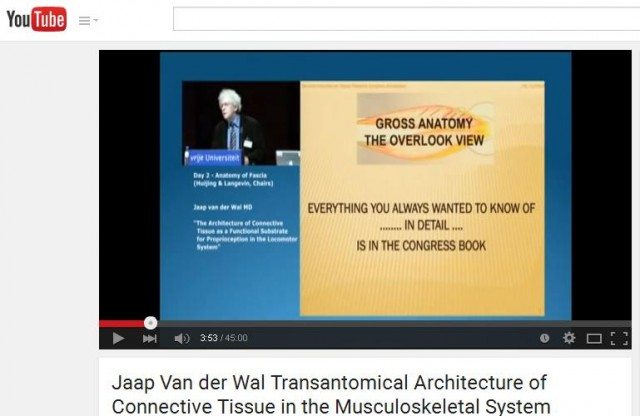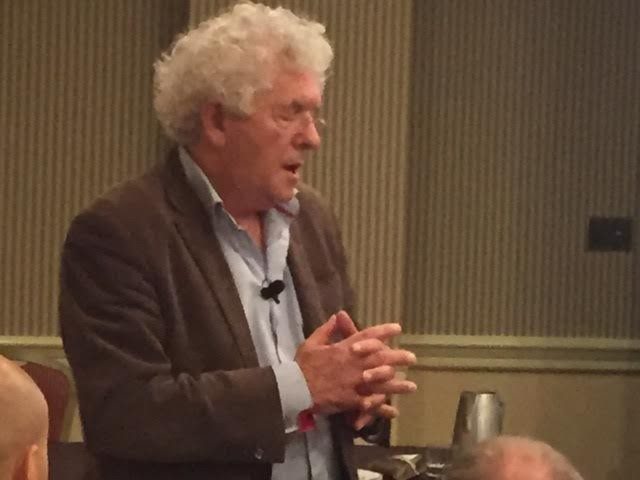We’ll have more to say about the 4th Fascia Research Congress, but I capped it off by spending a day trapped in an airless conference room on uncomfortable seats in the presence of one of the most passionate Renaissance thinkers in the anatomical world – Jaap van der Wal. Dr. van der Wal has been on my radar ever since the 2nd FRC in Amsterdam, where Dr. Peter Huijing generously featured his groundbreaking study of the anatomical relationships in the rat elbow in 1988.
Hunh? Rat elbow? and way back in1988, f’r cryin’ out loud? Yup, but the implications of his careful work were so radical that it was given the treatment that many new ideas are given: it was shelved and conveniently forgotten. But it was very much on display there, and I have been trying to grok his vision since. After that conference, I wrote an article on his work for Massage Magazine, which is referenced here: TomMyersDynamicLigaments (click for PDF of article)
You can also see his lecture for that congress here:
Jaap (who has more degrees and qualifications than nearly anyone you can name – medical doctor, anatomy professor, embryologist, and anthroposophical morphologist – but he is so accessible and sympatico, I hope both he and you will forgive me for using his first name for the remainder of this) spent the day correcting our common misperceptions about anatomy in a critique as damning as it is – once grasped – obvious and common-sensical. In spite of the bland surroundings and end-of-conference fatigue, I was not bored for a minute.
He began his talk on the embryology of fascia by changing the common translation of Descartes’ “Cogito, ergo sum” (I think, therefore I am) to “I doubt, therefore I am” – that the essential human experience is that of consideration, of the ability to doubt one’s perceptions and conclusions. He then went on to cast so many of our common beliefs into doubt in a delightful and convincing tour de force.
Jaap is a 21st century monist seeking to reconcile the dualism of mind and body, emphasizing the unity of physical and perceptual experience. My own way of saying this is to quote Buckminster Fuller – “I seem to be a verb”, and then aver that “Minding is something bodies do – i.e. saying ‘the mind’ is a fundamental error, our experience of mind is a process, not a thing.
Jaap’s ideas of morphogenesis draw a lot from the ideas of Goethe, as passed through Rudolph Steiner, with the embryology shaped by Blechschmidt. He’s no less a scientist for all that, but one who refuses to objectify, to take the common scientific “onlooker’s” point-of-view. His long-considered phenomenology gave us a heady brew of scientific exactness with a thoroughly human attitude to experience. I cannot do all these ideas justice, and some are already expressed in the article and talk referenced above, so here are some highlights.
How are we shaped? The common answer these days gives DNA an executive function in creating our form, and is commonly described in terms of ‘muscles attach to tendons that move (or stabilize) bones by means of joints limited by bone shape and ligaments’ Jaap destroys – or as he would say in his Dutch English, ‘destructs’ both these notions.
Anatomy describes ‘what’ and ‘where’, but not ‘how’ and ‘why’. In Jaap’s world, we give too much weight to what’s been realized – the end result of placement of tissues – and too little to the ‘realizing’ – the processes which give rise to the placement – which is, of course, the science of embryology. Understanding of embryology is fundamental to the process, but embryology is no longer much studied, and when it is nowadays, it is usually in terms of gene action in animals. Jaap follows Blechschmidt in asserting that regardless of the similarity (embryology is fundamentally conservative), humans are not recapitulating animals or going through animal stages, but a human is a human from the moment of conception (which, incidentally, has disturbing implications for the liberal side of the abortion debate – my comment, not Jaap’s).
In other words, your body is not a finished thing, as we often think and imply in our language, but rather a lifelong performance, a whole life’s worth of embryological growth.
Like Taoism, Jaap’s morphology rests on the interaction of polarities – hierarchies arise out of opposition, like yin and yang, Chaos and Cosmos. The first polarity in embryology, of course, is the fertilized zygote, a result of the interaction of the polarity of the ovum (huge, spherical, highly developed, passively floating, dying of obesity) and the sperm (tiny, simple, swimming upstream, a linear arrow, dying of anorexia – it has a few mitochondria, but little cytoplasm). I have long objected to the Darwinian, militaristic view of fertilization – the alpha male sperm as heat-seeking missile, hitting its target and piercing the egg to impregnate it – because it simply isn’t true.
The ovum is surrounded by the gel of the zona pellucida, an extra-thick version of the glycocalyx (sugary envelope) that surrounds most cells. The first alpha male sperm, the strongest swimmer who chose the right tube, reaches that jelly-like coating and explodes its warhead (to continue this inappropriate martial metaphor) of enzymes and dies having made a small pock-mark in the zona. It takes a number of sperm doing this until one gets close enough to communicate with the ovum, and there is a biochemical exchange between the two, to see whether this sperm is acceptable to the egg. If so, ‘she’ allows them to merge, fusing the nuclei and getting the whole growing process underway. Feeling a little useless, guys?
An interesting side note on the speed of physiology. How fast are cells metabolizing and dividing? Men are producing about 600 sperm cells per second (no wonder they’re a little stupid), whereas each ovary is maturing only one ovum every two months (from an original store of millions that are produced in the 5th month of pregnancy). At the height of brain growth, 4000 cell divisions are happening every second, but then it slows waaaaay doooown. Bone, cartilage, and tendon are way slowed down, too, turning over cells and adjacent proteins at a glacial rate. Bone marrow, however, is producing around 2500 white blood cells / second. Interesting to think of what parts of your body are really fast and adept, like the liver, and which parts of your body are slow and thus limited, like your neurons.
Like me, Jaap has a healthy disrespect for our current deification of neurons. Heart muscle has its own neural component, its own intelligence. Smooth muscle operates in waves, modulated, not controlled, by the neurons. Striated muscle is more modulated by nerves, of course, but not completely controlled by them. And the brain is only 10% neurons, while the role of the 90% of the brain which are (fascial) glial cells are at this time barely understood. Ah, well, that’s for another post.
This is already getting too long, and in trying to squeeze his 4-day course into one, he did some shortcuts that I cannot adroitly render on paper. Let’s do one more concept, and then I’ll end with a few choice lines.
The next polarization that produces a hierarchy is between the trophoblast and the embryoblast, where the outer circle of the trophoblast exhibits the centrifugal force that reaches out into the uterine lining to connect with the blood system of the mother – in other words, forming the placenta – while the embryoblast turns in on itself with the sagittal and lateral folds to produce the embryo itself. Your first ‘death’ is at birth, when you are separated from the other half of you – your placenta and chorionic sac.
The next polarization within the embryoblast is the ectoderm and endoderm, forming the inner skin (against the yolk sac) and the outer skin (against the amniotic sac). This bilaminar disc is all about surface.
Enter the mesoderm – literally entering between the two. According to Jaap, mesoderm is neither meso nor derm – it is the establishment of innerness. All the connective tissues form from this, so the fascia is the metamembrane that organizes the remaining 30% of endodermal and ectodermal cells into the body cavities and vectors. In this vision, muscle is a special form of connective tissue – I am beginning to think that muscle is just a special ‘condition’ of blood.
From here it gets quite complicated and needs pictures. Here’s a last couple of zingers for ponderment:
- Transparency of the eye lens is a an activity, not a property. Fluid blood results from an activity; it is not a property – if blood is still it coagulates.
- Fascia is the real inner, or perhaps, inter-. Ecto is an outside outside, Endo is an inside outside, Meso – fascia – is the innerness, the real middle. The two major gestures of mesechyme are to connect and to separate. Mesothelia line the body cavities – it is interstitial space.
- Every rib is a long bone and they look like a trunk – head, neck, two limbs at the top, and two limbs at the bottom. Just like a femur, tibia, humerus – all these bones look like a trunk.
Jaap will be coming to Maine for a four day collaboration with us next July – stay tuned!
-Tom Myers







